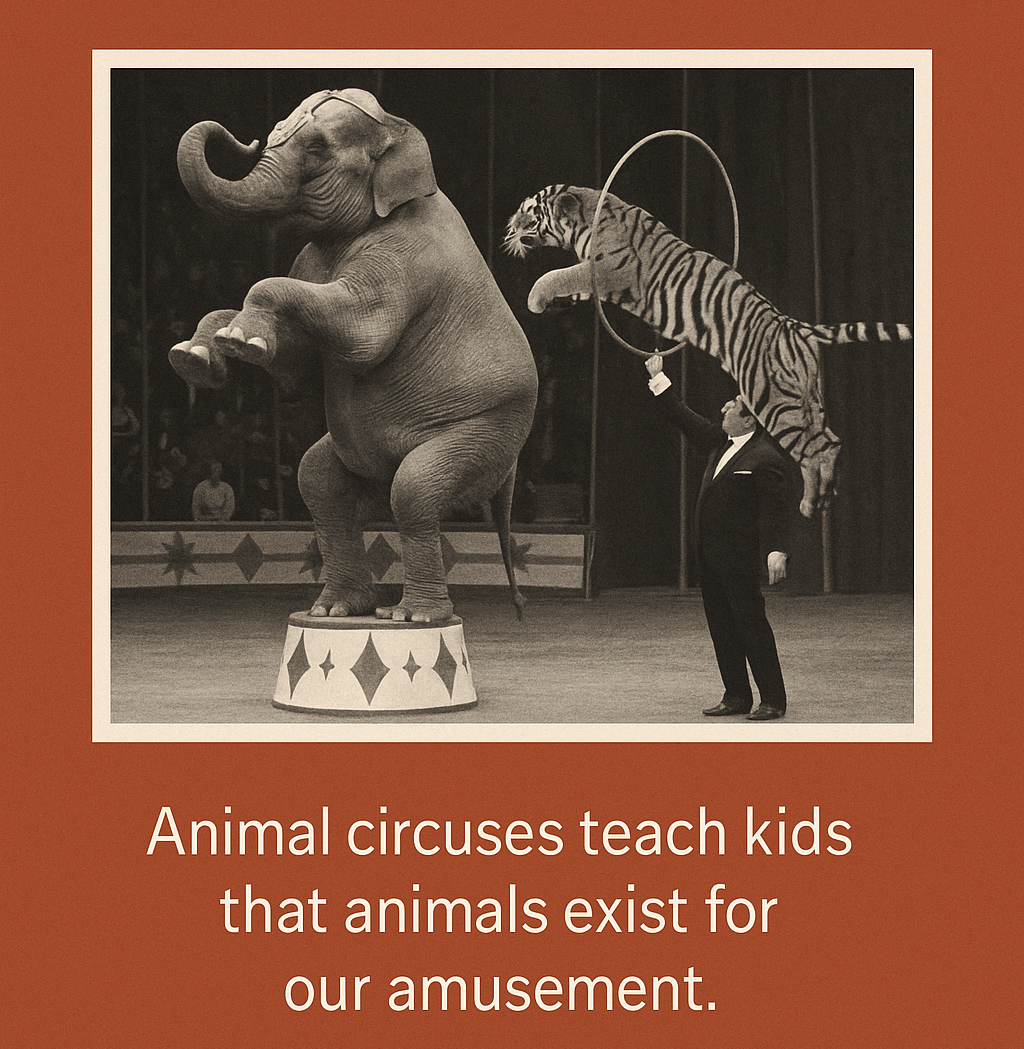What’s Really Behind the Big Top?
For years, the traveling circus has been a familiar sight in the LC Valley. The colorful posters go up, the tents are raised, free tickets are offered at local businesses, and families gather for a night of spectacle and tradition. But behind the performances and popcorn is a reality that often goes unseen … one that’s far less magical for the animals involved.
As communities across the country move away from the use of wild animals in entertainment, it’s time for us in the LC Valley to take a closer look at the ethics and consequences of allowing these acts to continue.
What Are We Teaching Our Children?
When we bring children to animal circuses, we’re not just exposing them to entertainment, we’re also shaping how they see and value animals.
Circuses teach kids that wild animals exist for our amusement. That it's normal, even acceptable, to see majestic elephants performing tricks, or tigers jumping through hoops, often under duress, these shows mask suffering with glitter and music, normalizing the idea that animals are here to serve us rather than live freely in their natural environments.
Instead of fostering respect, empathy, and understanding for other species, circuses often desensitize young audiences to cruelty. They blur the lines between education and exploitation, turning what should be awe for wild creatures into applause for forced performances.
Suppose we want to raise the next generation to care about wildlife and conservation. In that case, we must lead by example, by supporting humane, animal-free experiences that reflect kindness and respect for all living beings.
What You Don’t See Behind the Curtain
1. Elephants Endure Harsh Training
Elephants, known for their intelligence, deep emotional bonds, and complex social structures, are among the most exploited animals in circuses. To force them into performing tricks like standing on two legs or balancing on stools, trainers often use bullhooks, electric prods, and other tools designed to inflict pain and fear. This process, called “breaking the spirit,” begins at a young age. Many are torn from their mothers while still nursing and subjected to isolation and beatings during early training. These traumatic experiences leave lasting psychological scars, often resulting in abnormal behaviors such as swaying or rocking, a condition known as zoochosis. Far from being entertainment, this is prolonged suffering disguised as a show.
2. Big Cats Live in Tiny Cages
Lions and tigers in circuses spend nearly every hour in confinement, often in cages barely larger than their bodies. This lack of space leads to severe physical and mental health issues, including pacing, aggression, and depression.
3. Constant Travel Takes a Toll
Circus animals are constantly on the road, often housed in trucks or trailers with poor ventilation and limited access to food, water, and veterinary care. The stress of travel is relentless and can result in illness, injury, and early death.
4. Abuse Is a Regular Part of Life
To keep wild animals under control, some trainers rely on punishment — beatings, starvation, and other abusive tactics are well-documented in the industry.
5. Veterinary Care Is Lacking
Because profit drives most traveling acts, medical care is often overlooked. Untreated wounds, infections, and chronic illnesses go ignored, causing unnecessary pain and suffering.
6. Shortened Lifespans
Animals in circuses typically live far shorter lives than those in the wild. The stress, poor diet, and harsh living conditions contribute to this tragic fact.
7. Safety Risks for the Public
Wild animals are unpredictable, especially under stress. There have been numerous incidents of animals escaping, injuring trainers, or lashing out during performances, putting both staff and spectators at risk.
8. There Are Better Alternatives
Dozens of modern circuses have removed animals altogether, replacing them with acrobats, illusionists, and comedians. These shows are not only cruelty-free but also offer just as much wonder and excitement.
Idaho’s Silent Stance
Unfortunately, Idaho continues to rank among the worst states in the nation for animal protection laws. The state lacks:
A statewide ban on wild animals in circuses
Mandatory reporting laws for suspected animal cruelty
Restrictions on future animal ownership by those convicted of abuse
While a few municipalities like Boise and Ketchum have taken steps to ban traveling wild animal acts, most of the state, including the LC Valley, remains silent.
Washington Leads the Way
Just across the bridge, Washington has taken decisive action. In April 2025, Governor Bob Ferguson signed Senate Bill 5065 into law, making it illegal for traveling acts to use elephants, big cats, bears, and nonhuman primates. The law, which takes effect in July 2025, not only protects animals but also improves public safety.
With Washington joining 11 other states in banning these outdated forms of entertainment, Idaho’s lack of action is even more glaring.
Where We Go From Here?
The circus doesn’t need animals to be entertaining. As more states step up to protect wild animals from exploitation, it’s time we asked ourselves if the LC Valley should keep hosting these shows at all.
It’s easy to get caught up in nostalgia, but when the cost is lifelong suffering for animals, we have a responsibility to change course. Let’s call for better protections, support cruelty-free events, and be the voice for those who can’t speak.


